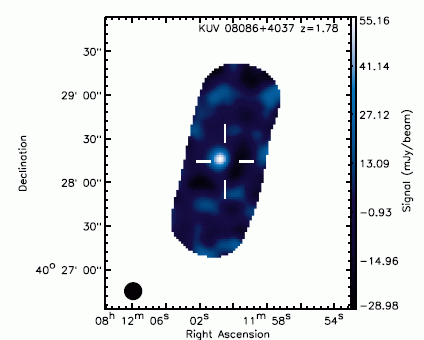
 SHARCII
imaged dust emission from very distant galaxies
SHARCII
imaged dust emission from very distant galaxies 
Using the
CSO/SHARCII
, two teams of astronomers have measured the total far-infrared energy
output of luminous galaxies in the distant universe. These
galaxies have an average redshift of z=3, meaning we are seeing light
emitted 11.5 billion years ago, when the universe was only 16% of it's
current age. The peak of the far-infrared spectrum, which is
normally at a wavelength near 100 micron for more nearby galaxies, is
redshifted to the 350 micron band that can be observed from the
CSO. By measuring the 350 micron emission from the galaxies,
Beelen et al. (2006)
and Kovacs et al (2006) were able to calculate the
full amount of power emerging in the far-infrared. For most of
the galaxies, this was done for the first time, and they are found to
shine with the luminosity of 10 trillion suns, or 1000 times the
luminosity of our own Milky Way galaxy. Beelen et al. observed
quasars, known to harbor supermassive black holes, and Kovacs et al.
observed galaxies which were discovered with the 850 micron SCUBA
camera on the JCMT. The results are to appear in the
Astrophysical Journal.

An example of
SHARCII 350 micron image of one
of the optically
luminous, radio-quiet
high-z quasars (Beelen
et al. 2006).

 SHARCII
imaged dust emission from very distant galaxies
SHARCII
imaged dust emission from very distant galaxies 

 SHARCII
imaged dust emission from very distant galaxies
SHARCII
imaged dust emission from very distant galaxies 
